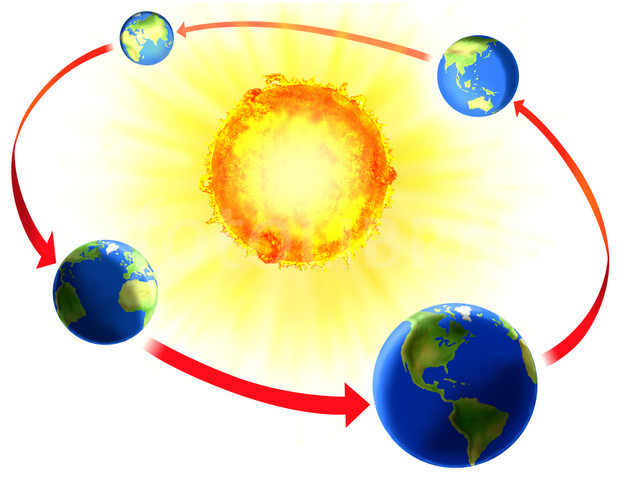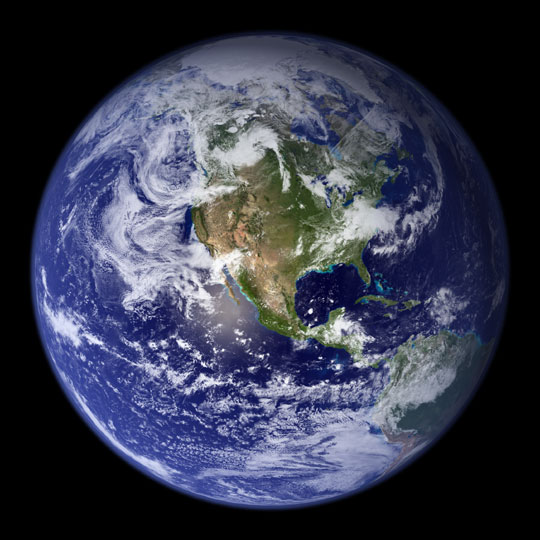The Earth's name came from the English/German name which means ground.
The Earth's diametre at the equator is 12,756.32 kilometres. The Earth's mass is 5.97 x 10^24 kilograms. The Earth's density is 5.51 grams per cubic centimetre.
The Earth revolves around the Sun. It takes approximately 365 days to revolve around the sun.

The Earth is tipped on an axis. It is tipped on this axis approximately 23.5 degrees from vertical. The Earth rotates once in 24 hours. It does this at a rate of 1609.344 kilometres per hour.
Where we live on the Earth, there are four seasons. They are spring, summer, autumn, and winter. The least warm recorded temperature is -89.4 degrees celsius. The warmest recorded temperature was 56.7 degrees celsius.
The Earth's atmosphere is made many different gases. The Earth is 78% nitrogen, 21% oxygen, 0.003% carbon dioxide (This increases due to pollution), and other gases such as neon, methane, krypton, and hydrogen.
The Earth is the third planet from the Sun. The minimum distance is 146 million kilometres. The maximum is 152 million kilometres. The mean of this amount is exactly one AU.
The Earth was discovered aproximately 3 million years ago by the first human. I think that they just looked down.
The moon is the brightest object in the sky besides the Sun. The moon orbits around the Earth once a month.
(Each of the four lines symbolizes one of the four elements.) 
Above you can see the symbol that stands for Earth. You can use this during Ms. D's class instead of writing the word Earth.
The Earth does not and probably never had rings.
Interesting Facts:
- The Earth is the densest major body in our solar system
- The Atmosphere of Earth extends about 10,000 kilometres
- Molten iron core makes a magnetic field
- Actually takes 23 hours and 56 minutes to rotate
- One Earth year is actually 365.2564 days. NOT 365
- The Extra 0.2564 causes leap years to occur
http://www.youtube.com/watch?v=1V2J0oBj42Y&feature=relmfu

Hi Reza!
ReplyDeleteThis is a pretty good post. I like cool pictures and interesting facts! You could still have changed some things, though; these include having more colors, another link, a more exciting voice, and explaining what the four elements are. You also forgot to caption one of your pictures and you forgot "Scribe Post" as one of your labels. It would have been nice if you would have had more detail about how the iron core makes a magnetic field, and how the tip of Earth's axis affects us. Other than that, I really like the facts you put in your post! Nice job! ;)
Reza - Not bad, but I feel your last post was more in-depth and followed the rubric more closely. You have a great link, but are missing the link to Moodle and your notes. I like the pictures you included, but only one of them has a caption. I am not sure why you have used only one color, and I think having some bold words would have been helpful in your spacing and different topics. You need more information about the moon and missions, plus your science about revolution & rotation is too general. Which leads to your five facts - these are things you needed to find, they are not extras, so I do not feel you met this requirement. Nice coverage of the numbers and your spelling looks great throughout. Maybe next time you should review the rubric more closely before posting your Scribe Post (missing in labels). ~Ms. D.
ReplyDeleteHi Reza!
ReplyDeleteI think this an ok post. I like your pictures and thefacts that you brout up about the earth and I also think the video that you put I think it is good and kind of help full. But I also think that you could put more pictures and use mor colors and maby you could put more links.